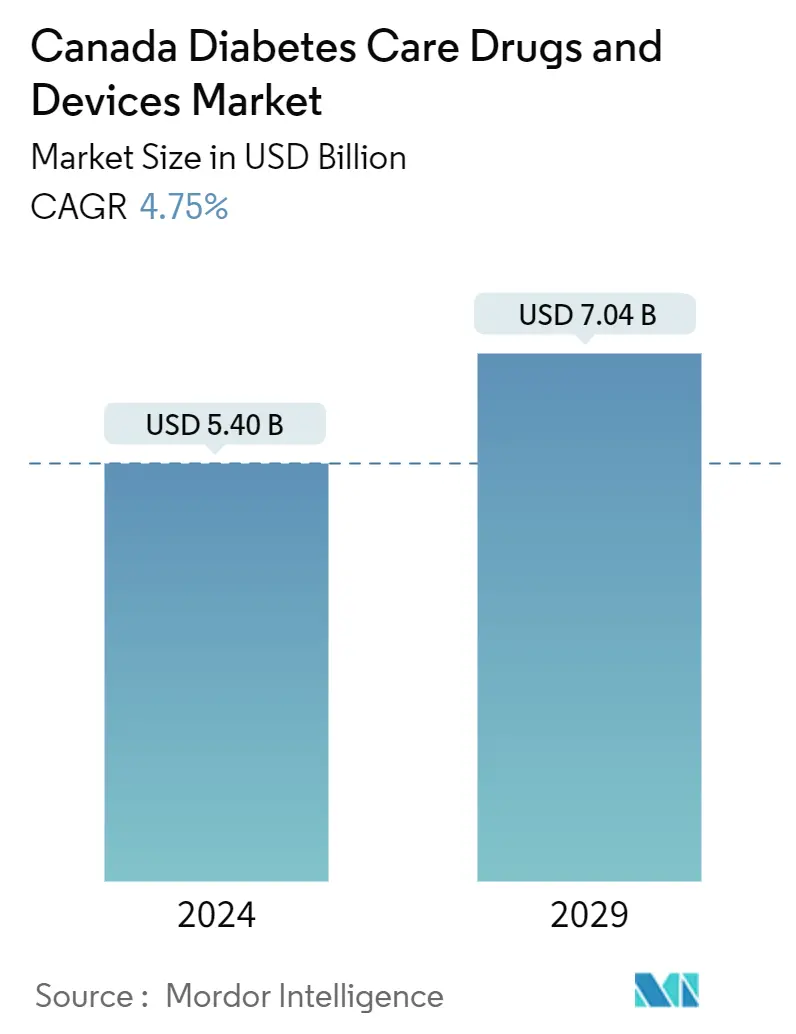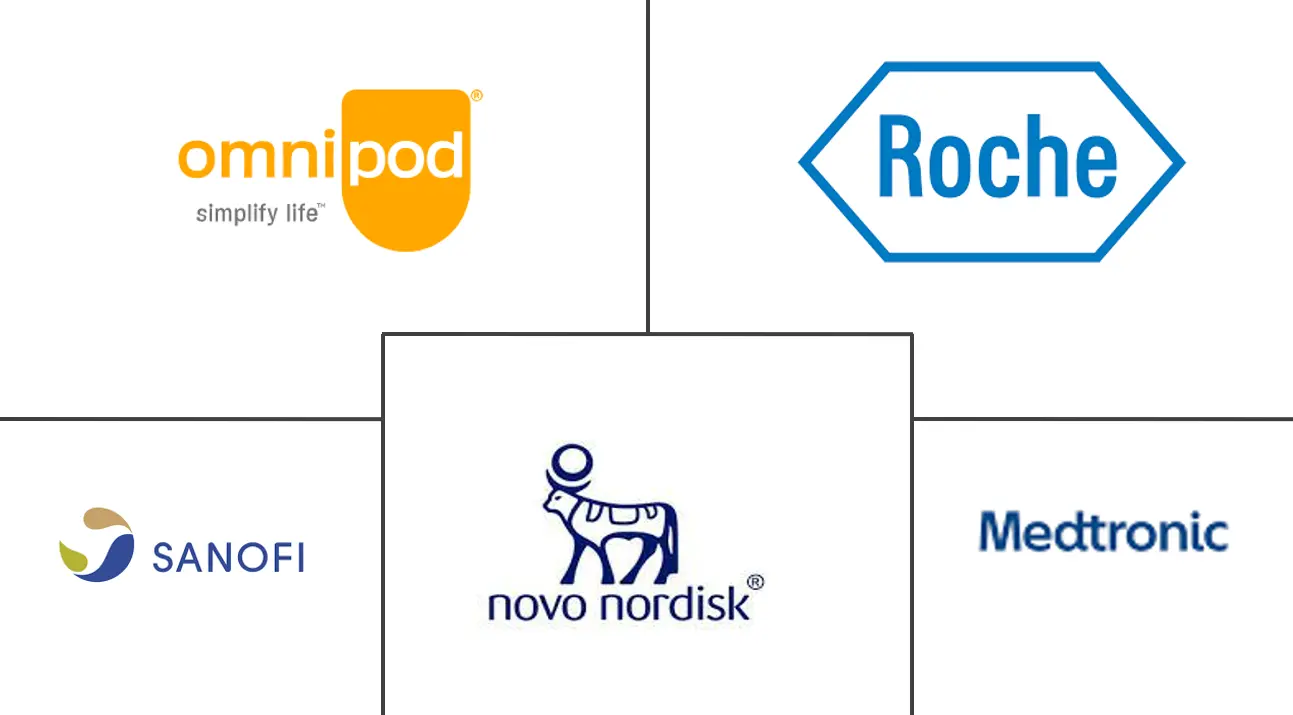Market Size of Canada Diabetes Care Drugs And Devices Industry

| Study Period | 2019 - 2029 |
| Base Year For Estimation | 2023 |
| Forecast Data Period | 2024 - 2029 |
| Market Size (2024) | USD 5.40 Billion |
| Market Size (2029) | USD 7.04 Billion |
| CAGR (2024 - 2029) | 4.75 % |
Major Players
*Disclaimer: Major Players sorted in no particular order |
Canada Diabetes Care Drugs & Devices Market Analysis
The Canada Diabetes Care Drugs And Devices Market size is estimated at USD 5.40 billion in 2024, and is expected to reach USD 7.04 billion by 2029, growing at a CAGR of 4.75% during the forecast period (2024-2029).
In Canada, public health is overseen at the federal, provincial, and regional levels, and the Canadian constitution delegates healthcare authority to the country's ten provinces and three territories. As a result, like the United States, where individual states generally define the COVID-19 response, Canadian provinces mostly selected containment and mitigation plans. Provincial public health authorities collaborated closely with regional public health officers and municipal governments to develop policies and recommendations and put services like testing and contact tracing in place.
Blood pressure regulation was a critical component of diabetes management. Furthermore, even without high blood pressure, certain blood pressure-lowering medications were frequently recommended for people with diabetes to protect them from kidney and heart-related complications. No scientific evidence linked these blood pressure drugs to the likelihood of COVID-19 infection or associated consequences.
In Canada, during the pandemic, many healthcare providers have adopted a hybrid model of care, offering certain types of visits in-person at the clinic and others virtually, by phone, video chat, or secure messaging. Virtual diabetes care may be a new and different experience for you. For tips on preparing for your diabetes visit and managing virtual appointments. Yet, an insulin vial costs less than C$50 in Canada. More and more Americans are traveling up to the north in search of less expensive insulin to store up. Although importing unapproved medications from Canada is technically against the law, regulators often have no problem with people trying to save money while traveling. Those who import medicine for personal use in quantities less than three months "usually do not object," according to the FDA website.
Canada Diabetes Care Drugs & Devices Industry Segmentation
Canada Diabetes Care Drugs and Devices Market witnessed USD 4.7 billion in the current year and is anticipated to register a CAGR of over 4% during the forecast period. The Canada Diabetes Care Drugs and Devices Market is segmented into Drugs (by Category (Insulin, Oral Anti-Diabetic Drugs, Non-Insulin Injectable Drugs, and Combination Drugs), by sub-segment (Basal or Long-acting, Bolus or Fast-acting, Traditional Human Insulin Drugs, Insulin Biosimilars, GLP-1 Receptor Agonists, Alpha-Glucosidase Inhibitors, DPP-4 Inhibitors, and SGLT-2 Inhibitors)) and Devices (Management Devices (Insulin Pumps, Insulin Pens, Syringes, Cartridges, and Jet Injectors) and Monitoring Devices (Self-monitoring Blood and Continuous Glucose Monitoring)). The report offers the market size in value terms in USD for all the abovementioned segments.
| Drug | ||||||||||||||||||||||||||||||
| ||||||||||||||||||||||||||||||
| ||||||||||||||||||||||||||||||
| ||||||||||||||||||||||||||||||
| ||||||||||||||||||||||||||||||
|
| Devices | |||||||||||
| |||||||||||
|
Canada Diabetes Care Drugs And Devices Market Size Summary
The Canadian diabetes care drugs and devices market is poised for steady growth over the forecast period, driven by an increasing prevalence of diabetes and the rising demand for effective management solutions. The market landscape is shaped by the decentralized healthcare system in Canada, where provincial authorities play a significant role in public health initiatives. This has led to the adoption of hybrid care models, combining in-person and virtual consultations, which have become more prevalent during the COVID-19 pandemic. The market is also influenced by the cost of diabetes care, with insulin prices being a notable factor, as many Americans seek cheaper alternatives in Canada. The introduction of Continuous Glucose Monitoring (CGM) devices, although limited in public funding, is gaining traction, supported by updated clinical guidelines and government encouragement.
The market is characterized by continuous innovation and strategic collaborations among key players such as Abbott, Medtronic, and Novo Nordisk, who are investing heavily in research and development to maintain their competitive edge. The approval of advanced devices like the Dexcom G7 CGM system and needle-free insulin delivery systems by Health Canada highlights the ongoing advancements in diabetes care technology. Despite financial constraints and the high cost of diabetes management, there is a strong emphasis on patient-centered care and the need for further investment in diabetes research. The market's growth is also supported by the efforts of organizations like Diabetes Canada and the Canadian Pharmacists Association, which are actively monitoring and addressing the challenges posed by the increasing diabetes rates in the country.
Canada Diabetes Care Drugs And Devices Market Size - Table of Contents
-
1. MARKET DYNAMICS
-
1.1 Market Overview
-
1.2 Market Drivers
-
1.3 Market Restraints
-
1.4 Porter's Five Forces Analysis
-
1.4.1 Bargaining Power of Suppliers
-
1.4.2 Bargaining Power of Consumers
-
1.4.3 Threat of New Entrants
-
1.4.4 Threat of Substitute Products and Services
-
1.4.5 Intensity of Competitive Rivalry
-
-
-
2. Market Segmentation
-
2.1 Drug
-
2.1.1 Oral anti-diabetic drugs
-
2.1.1.1 Biguanide
-
2.1.1.1.1 Metformin
-
-
2.1.1.2 Alpha - Glucosidase inhibitors
-
2.1.1.2.1 Alpha - Glucosidase inhibitors
-
-
2.1.1.3 Dopamine -D2 receptor agonist
-
2.1.1.3.1 Bromocriptin( Cycloset)
-
-
2.1.1.4 Sodium - glucose cotransport -2 (SGLT-2) inhibitor
-
2.1.1.4.1 Invokana (Canagliflozin)
-
2.1.1.4.2 Jardiance (Empagliflozin)
-
2.1.1.4.3 Farxiga/Forxiga (Dapagliflozin)
-
2.1.1.4.4 Suglat (Ipragliflozin)
-
-
2.1.1.5 Dipeptidyl peptidase - 4 (DPP-4) inhibitors
-
2.1.1.5.1 Januvia (Sitagliptin)
-
2.1.1.5.2 Onglyza (Saxagliptin)
-
2.1.1.5.3 Tradjenta (Linagliptin)
-
2.1.1.5.4 Vipidia/Nesina (Alogliptin)
-
2.1.1.5.5 Galvus (Vildagliptin)
-
-
2.1.1.6 Sulfonylureas
-
2.1.1.6.1 Sulfonylureas
-
-
2.1.1.7 Meglitinide
-
2.1.1.7.1 Meglitinide
-
-
-
2.1.2 Insulin
-
2.1.2.1 Basal or Long Acting Insulins
-
2.1.2.1.1 Lantus (Insulin Glargine)
-
2.1.2.1.2 Levemir (Insulin Detemir)
-
2.1.2.1.3 Toujeo (Insulin Glargine)
-
2.1.2.1.4 Tresiba (Insulin Degludec)
-
2.1.2.1.5 Basaglar (Insulin Glargine)
-
-
2.1.2.2 Bolus or Fast Acting Insulins
-
2.1.2.2.1 NovoRapid/Novolog (Insulin Aspart)
-
2.1.2.2.2 Humalog (Insulin Lispro)
-
2.1.2.2.3 Apidra (Insulin Glulisine)
-
2.1.2.2.4 FIASP (Insulin Aspart)
-
-
2.1.2.3 Traditional Human Insulins
-
2.1.2.3.1 Novolin/Actrapid/Insulatard
-
2.1.2.3.2 Humilin
-
-
-
2.1.3 Combination Insulins
-
2.1.3.1 NovoMix (Biphasic Insulin Aspart)
-
2.1.3.2 Ryzodeg (Insulin Degludec and Insulin Aspart)
-
2.1.3.3 Xultophy (Insulin Degludec and Liraglutide)
-
2.1.3.4 Soliqua/Suliqua (Insulin Glargine and Lixisenatide)
-
-
2.1.4 Oral Combination
-
2.1.4.1 Janumet (Sitagliptin and Metformin HCl)
-
-
2.1.5 Non-Insulin Injectable drugs
-
2.1.5.1 GLP1 receptor agonists
-
2.1.5.1.1 Victoza (Liraglutide)
-
2.1.5.1.2 Byetta (Exenatide)
-
2.1.5.1.3 Bydureon (Exenatide)
-
2.1.5.1.4 Trulicity (Dulaglutide)
-
2.1.5.1.5 Lyxumia (Lixisenatide)
-
-
2.1.5.2 Amylin Analogue
-
2.1.5.2.1 Symlin (Pramlintide)
-
-
-
-
2.2 Devices
-
2.2.1 Monitoring Devices
-
2.2.1.1 Self-Monitoring Blood Glucose
-
2.2.1.1.1 Glucometer Devices
-
2.2.1.1.2 Blood Glucose Test Strips
-
2.2.1.1.3 Lancets
-
-
2.2.1.2 Continuous Glucose Monitoring
-
2.2.1.2.1 Sensors
-
2.2.1.2.2 Durables
-
-
-
2.2.2 Management Devices
-
2.2.2.1 Insulin Pump
-
2.2.2.1.1 Insulin Pump Device
-
2.2.2.1.2 Insulin Pump Reservoir
-
2.2.2.1.3 Infusion Set
-
-
2.2.2.2 Insulin Syringes
-
2.2.2.3 Cartridges in Reusable pens
-
2.2.2.4 Insulin Disposable Pens
-
2.2.2.5 Jet Injectors
-
-
-
Canada Diabetes Care Drugs And Devices Market Size FAQs
How big is the Canada Diabetes Care Drugs And Devices Market?
The Canada Diabetes Care Drugs And Devices Market size is expected to reach USD 5.40 billion in 2024 and grow at a CAGR of 4.75% to reach USD 7.04 billion by 2029.
What is the current Canada Diabetes Care Drugs And Devices Market size?
In 2024, the Canada Diabetes Care Drugs And Devices Market size is expected to reach USD 5.40 billion.

